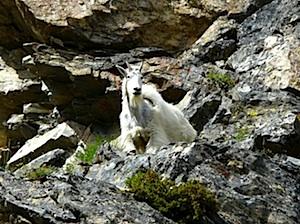While many long to see mountain goats in the wild, at Grand Teton National Park biologists are trying to figure out how to deal with non-native goats that pose a threat to the park's bighorn sheep.
Park staff is working on a management plan and environmental assessment with an aim to support long-term protection for the mountain ecosystem and its associated native species in Grand Teton and the John D. Rockefeller, Jr. Memorial Parkway.
Public comments will be accepted during a scoping period now through December 13. You can find more information on the matter, and leave your comments, at this site (when it's operational. It was down Thursday morning).
Biologists want to address the impacts of non-native mountain goats; those impacts could include the loss or alteration of native ecosystems, especially native plant and animal communities, and effects on bighorn sheep, a native species of conservation concern. Primary reasons for evaluating management actions, which may involve potential removal of mountain goats from Grand Teton and the Parkway include: Resource damage; use of limited natural resources (habitat and food); competition with a small, genetically isolated population of native bighorn sheep; and potential risk of disease transmission to bighorn sheep.
Mountain goats currently found in the Teton Range are colonizers from herds that developed after goats were transplanted by the Idaho Fish and Game Department into the Snake River Range and Big Hole Mountains of southeastern Idaho beginning in 1969. These areas are about 20 miles from the southwest boundary of Grand Teton.
Although mountain goats are native to northern mountain ranges in the western United States, including some in northern Idaho and Montana, the southeast Idaho transplant locations were outside their historical range. Within a decade, goats were occasionally seen in the Teton Range, however sightings were sporadic and the animals appeared transient.
Since 2008, park biologists have documented groups of mountain goats including nannies (adult females) with kids (young of the year) annually within Grand Teton National Park. These observations strongly suggest that goats are in the early stages of establishing a population in the Teton Range. Goat activity has primarily been concentrated in the Cascade Canyon area of the Tetons, but recent sightings have occurred throughout the mountain range.




Add comment